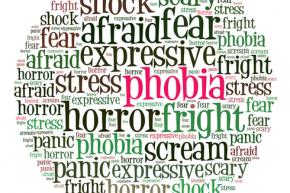In this post, I’m going to talk about trigger warnings. I’m going to point out problems with their usage, from a clinical/psychological point of view. Please read the whole thing before you comment or accuse me of being an insensitive jerk, or you could very well look silly by jumping the gun, as it were.
As a scientist, I like to have a strong operational definition of a term before discussing it. When I went about online trying to find an agreed-upon definition for “trigger warning” though, I came up surprisingly short-handed. In fact, just the history of the term and its usage isn’t exactly an easy thing to track down. The longest and most detailed description came from Geek Feminism Wiki, while Wikipedia doesn’t even give the term a full-page to itself, instead subsuming it under the (very problematic) entry on “trauma trigger.” In fact, the best definition I could find actually came from Urban Dictionary, of all places:
Before I go directly into talking about trigger warnings, though, it will be very useful for my readers to understand two things. The first is how people’s reactions to traumatic or fearful events and other stimuli can go from normal to abnormal, or from expected to unexpected and problematic. The second is how we (and by “we” I mean mental health providers) effectively treat people who have problems like phobias and post-traumatic stress disorder, which are the result of exaggerated fear/anxiety responses. Afterwards, I’ll make explicit what a “trigger warning” implies, based on this information, and why I see the use of them as problematic. We then wrap up with a bit of nuance.
—————————-
Why am I Afraid?
Everyone is afraid of things. It’s natural to be so, and many of us would die much sooner in life if we showed no fear or anxiety to new and novel stimuli, or to stimuli that had caused us pain and fear in the past (e.g., “Oh, there’s a snake. The last one bit me in the face, but I’m sure things will be different this time! Off I go to pick it up by the head!”).
It’s when you are afraid of things unreasonably (meaning stimuli or situations that are not actually dangerous) or to such a great degree that it causes functional impairment and a decrease in quality of life that fears and anxiety go from normal to abnormal. But how to do they get there?
 If we are talking about more “simple” fears, such as specific phobias, we tend to have several useful frameworks to look at why certain people develop unreasonable fears and others don’t. For example, what we call the associative model of fear developed from animal models of fear, with some of the earliest work being done by John B. Watson using only classical conditioning (the famous – or infamous – “Little Albert” studies). As knowledge about operant conditioning grew, however, O. Hobart Mowrer’s two‐factor theory of avoidance learning became highly influential. In this theory, fears develop initially via classical conditioning and are then maintained via the operant conditioning process of negative reinforcement. For example, a girl gets attacked by a dog, classically associating the dog with fear; she then goes out of her way to avoid dogs, such as crossing the street to avoid encounter one, not going into pet stores, or declining invitations to parties where the host has a dog, negatively reinforcing that avoidance.
If we are talking about more “simple” fears, such as specific phobias, we tend to have several useful frameworks to look at why certain people develop unreasonable fears and others don’t. For example, what we call the associative model of fear developed from animal models of fear, with some of the earliest work being done by John B. Watson using only classical conditioning (the famous – or infamous – “Little Albert” studies). As knowledge about operant conditioning grew, however, O. Hobart Mowrer’s two‐factor theory of avoidance learning became highly influential. In this theory, fears develop initially via classical conditioning and are then maintained via the operant conditioning process of negative reinforcement. For example, a girl gets attacked by a dog, classically associating the dog with fear; she then goes out of her way to avoid dogs, such as crossing the street to avoid encounter one, not going into pet stores, or declining invitations to parties where the host has a dog, negatively reinforcing that avoidance.
Vicarious conditioning can also play an important role in associative learning, via modeling (a child sees a parent display fear or disgust to stimuli, and then patterns her behavior after that), information transmission (hearing about how dangerous it is to fly due to terrorists), and visual observation of fear (watching someone else encounter a stimuli and display fear reactions). The impact of these types of associative learning, however, appear to be strongly mediated by nonassociative factors, such as evolutionary preparedness and innate fears.
The key concept here is that fear is maintained via avoidance and escape behaviors. When we are confronted by a worrying/frightening stimuli and we avoid it, we feel better. This makes us more likely to do that same type of behavior (avoidance) in the future when we are exposed to a similar stimuli. Seems smart, right? If something’s dangerous and scary, you stay away from it, seems reasonable. The problem with this is two-fold.
![polls_kermit_evil_1_5255_587004_answer_2_xlarge[1]](https://skepticink.com/gps/files/2014/07/polls_kermit_evil_1_5255_587004_answer_2_xlarge1.jpeg) First, people who have phobias, OCD, PTSD, and the like are not actually responding to dangerous stimuli in a normal way – they are responding to things that should not be fear-provoking as if they were. As just a few examples, I’ve seen people with phobias of snakes and heights (both of which can be dangerous, certainly), but also with clinical-level phobias of bubblegum, frogs, and clowns. Very few people are killed each year by frogs and clowns (or even snakes, for that matter; maybe only five per year out of 7,000-8,000 bites).
First, people who have phobias, OCD, PTSD, and the like are not actually responding to dangerous stimuli in a normal way – they are responding to things that should not be fear-provoking as if they were. As just a few examples, I’ve seen people with phobias of snakes and heights (both of which can be dangerous, certainly), but also with clinical-level phobias of bubblegum, frogs, and clowns. Very few people are killed each year by frogs and clowns (or even snakes, for that matter; maybe only five per year out of 7,000-8,000 bites).
The second problem is that avoidance and escape are short-term solutions only. The more you avoid certain stimuli (or triggers), the more fear provoking they become, making you more worried, anxious, and scared of them. This maintains rather than destroys your fears and worries, making them worse across time. These fear-motivated behaviors are short-term solutions (“Whew, now I feel less anxious or scared.”) that result in long-term problems (“Oh shite, now I have a phobia.”).
In anxiety problems such as PTSD and OCD, very similar processes are occurring. That is, a person encounters stimuli which cause psychological distress and/or unpleasant physiological arousal, often because they have been linked to very unpleasant emotions in the past. Typical examples include hearing loud noises (for combat veterans, such noises can be linked to memories of being shot at by enemy forces) or having to touch a door knob (for those with contamination OCD symptoms, they see it as filthy and teeming with germs, which could make them sick).
Now in PTSD, the ultimate thing that is usually trying to be avoided is one’s own memory for a traumatic incident. For someone who is sexually assaulted, this may result in avoidance of certain words, people who look like the assailant, or places similar to where the assault occurred. In OCD, the avoidance is usually instead focused on triggers that cause obsessions, which in turn result in compulsions that help reduce the anxiety.
TL;DR – We get more anxious and distressed by something the more we avoid it. Doing this often enough can lead to developing very severe fear of particular kinds of stimuli.
—————————-
How Do I Get Over Being Afraid?
One can use certain kinds of medication to assist with clinical-level fears or anxiety (e.g., serotonin reuptake inhibitors for OCD and PTSD), but the treatments with the highest level of effectiveness tend to be behavioral therapies focusing on exposure with response prevention (EX/RP). EX/RP focuses on exposing you to a feared stimuli, then preventing your typical, fear/anxiety-based response.
 For example, let’s say you are afraid of mice. When you see one, you typically try to run away (escape and avoidance behaviors to reduce your anxiety). A typical EX/RP treatment would expose you, gradually, to different types of stimuli that were mouse-related and not let you escape and avoid it. First it might be just saying the word “mouse” (or writing it) over and over again until you had no anxiety when doing that. Then it might be looking at a picture of a mouse until you have no fear/anxiety when doing so. You would work your way up until (eventually) you were holding a mouse in your hand with no fear/anxiety.
For example, let’s say you are afraid of mice. When you see one, you typically try to run away (escape and avoidance behaviors to reduce your anxiety). A typical EX/RP treatment would expose you, gradually, to different types of stimuli that were mouse-related and not let you escape and avoid it. First it might be just saying the word “mouse” (or writing it) over and over again until you had no anxiety when doing that. Then it might be looking at a picture of a mouse until you have no fear/anxiety when doing so. You would work your way up until (eventually) you were holding a mouse in your hand with no fear/anxiety.
(This is a pretty simplistic explanation for illustrative purposes. To get a better idea of how EX/RP works, in this case for OCD, see this self-guided workbook. If you really want to dig in deep, I’d recommend this text.)
Initially, this seems counterintuitive – let’s treat your fear by EXPOSING YOU TO THE THING YOU FEAR THE MOST!!! And, I won’t lie, most people with clinical-level fears and anxiety look at me like I am absolutely insane when I outlined an EX/RP protocol. But, it turns out that it works brilliantly.
Treating fears/anxiety this way has very good outcomes, from up to 75% of people with OCD seeing a significant decrease in symptoms to 95% of individuals with simple phobias. What’s extra nice is that the effects are usually quite long-lasting, as a major component of treatment is that the therapist focuses on teaching individuals what to do in the future to prevent more problems.
TL;DR – We get over fears by facing them and not giving in to anxiety by avoiding and escaping fear-causing stimuli.
—————————-
What Does This Have to Do with Trigger Warnings?
The entire point of trigger warnings is to let people know that something they are afraid of is getting ready to be shown or discussed. The Geek Feminism Wiki puts it like this:
Trigger warnings are customary in some feminist and other spaces. They are designed to prevent people who have an extremely strong and damaging emotional response (for example, post-traumatic flashbacks or urges to harm themselves) to certain subjects from encountering them unaware. Having these responses is called “being triggered”.
In other words, people are being told “This could make you feel bad, so don’t look at it!” Such a viewpoint seems to make sense up front, in that people don’t typically want to read/see things which are going to make them feel negative emotionally. In fact, it is normal to escape and avoid those things that make us uncomfortable (as I talked about above).
This also seems (to me at least) to imply that you, as an individual who has undergone a traumatic event or events, now need to be coddled and protected. This is very much what those of us in mental health refer to as a “victim mentality.” Instead, we need to help people who have endured trauma learn how to effectively cope with it, stand strong against reminders of it, and move from being a victim to being a survivor. This writer sums up my thoughts about these two words and difference in their connotation:
‘Victim’ implies passivity, acceptance of one’s circumstances, and a casualty. The word ‘victim’ robs individuals of their agency and their ability to fight back. ‘Survivor’ displays the individual’s resistance, ability to take action in the face of immense obstacles, and the day-to-day work of surviving despite immense trauma. ‘Survivor’ implies ingenuity, resourcefulness, and inner strength.
So, one of my problems with trigger warnings is that they appear emphasize a “poor victim” mentality for people, rather than a “strong survivor” mentality. By saying “there is something scary this way, you don’t need to see it!” the writer of a trigger warning is acting as a self-appointed guardian of what s/he thinks someone with trauma should or should not be exposed to. People who have been exposed to traumatic experiences do not need to be protected, they need to be encouraged to grow and heal.
A second problem I have with trigger warnings is this: What happens when someone sees a trigger warning and because of that does not engage with that material but instead clicks away to another page? They have then been exposed to a feared stimulus and have escaped and avoided it. In that way, trigger warnings may merely prolong anxiety via reinforcing escape and avoidance behaviors, rather than actually helping someone feel better across the long-term.
My third major concern with trigger warnings is where do they stop? Most people probably only consider them necessary for “extreme” trauma such as sexual assault or combat. However, as a specialist in the treatment of anxiety, I have seen people become completely unhinged when initially confronted with feared stimuli that included bubble gum, frogs, holes, and many other things that most people would not consider “traumatic.” I have also seen flashbacks and severe dissociative reactions triggered in those with PTSD by such an astounding number of sounds, sights, smells, and phrases that I could fill a book with them. So, should one attempt to include a warning about anything that could potentially be a “trigger” for a reader? If we did, our writing would come to resemble the disclaimers in television ads for drugs, with two pages of warnings and one page of content. Where does one draw the line? Do we need to start including trigger warnings, for instance, in college classes? Some people seem to think so, but doing so would certainly be problematic, as the linked author says:
What began as a way of moderating Internet forums for the vulnerable and mentally ill now threatens to define public discussion both online and off….As a means of navigating the Internet, or setting the tone for academic discussion, the trigger warning is unhelpful. Once we start imposing alerts on the basis of potential trauma, where do we stop?
TL;DR – Trigger warnings emphasize a victim rather than survivor role for the potential reader, as well as potentially increasing distress in the long-term via reinforcement of avoidance behaviors.
—————————-
Nuance in Usage, Rather than Demands
Now, my thoughts as outlined above should not be misconstrued into the position that I think we should just be shoving disturbing or potentially triggering material down people’s throats. Certainly not. Rather, I think that warning people that what you are about to show them could be highly disturbing is sometimes useful.
 For instance, when I teach my seminar course focusing on Anxiety Disorders, we watch a film called Martha Marcy May Marlene that has the main character experiencing many PTSD symptoms after repeated abusive experiences. These experiences are depicted in the film, and so I tell my students that they are likely going to be disturbed by some of the imagery and happenings in the film. I don’t then tell them to leave if they think they will be disturbed, though. I tell them why I am showing it and explain how it contributes to their understanding of the disorder. We then proceed to watch the film together.
For instance, when I teach my seminar course focusing on Anxiety Disorders, we watch a film called Martha Marcy May Marlene that has the main character experiencing many PTSD symptoms after repeated abusive experiences. These experiences are depicted in the film, and so I tell my students that they are likely going to be disturbed by some of the imagery and happenings in the film. I don’t then tell them to leave if they think they will be disturbed, though. I tell them why I am showing it and explain how it contributes to their understanding of the disorder. We then proceed to watch the film together.
Unlike some people, I am not calling for a “ban” on trigger warnings, or completely decrying their usage in all situations. I do, however, think that they can be highly problematic, for the reasons I gave above. So, before you drop a TW, think about what it says about you as well as your audience.

